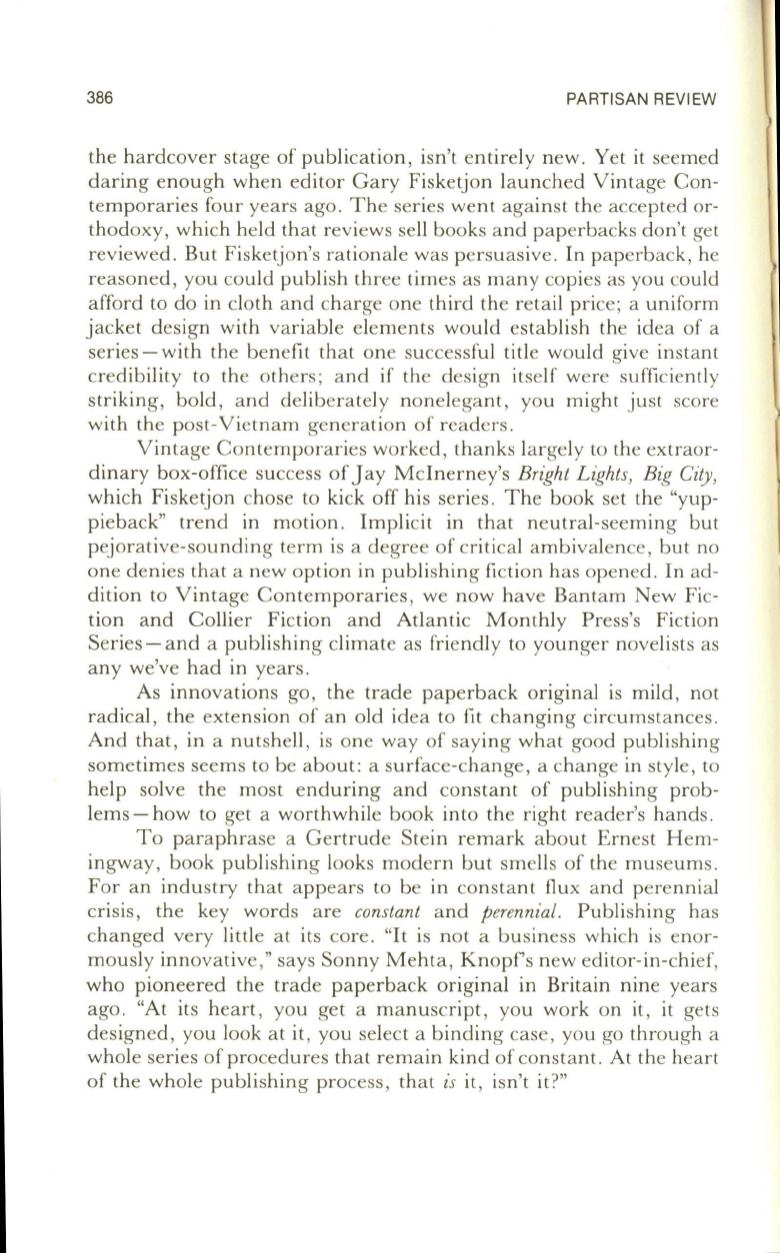
386
PARTISAN REVIEW
the hardcover stage of publication, isn't entirely new. Yet it seemed
daring enough when editor Gary Fisketjon launched Vintage Con–
temporaries four years ago. The series went against the accepted or–
thodoxy, which held that reviews sell books and paperbacks don't get
reviewed. But Fisketjon's rationale was persuasive. In paperback, he
reasoned, you could publish three times as many copies as you could
afford to do in cloth and charge one third the retail price; a uniform
jacket design with variable elements would establish the idea of a
series - with the benefit that one successful title would give instant
credibility to the others; and if the design itself were sufficiently
striking, bold, and deliberately nonelegant, you might just score
with the post-Vietnam generation of readers.
Vintage Contemporaries worked, thanks largely to the extraor–
dinary box-office success of Jay McInerney's
Bright Lights, Big City,
which Fisketjon chose to kick off his series. The book set the "yup–
pieback" trend in motion. Implicit in that neutral-seeming but
pejorative-sounding term is a degree of critical ambivalence, but no
one denies that a new option in publishing fiction has opened. In ad–
dition to Vintage Contemporaries, we now have Bantam New Fic–
tion and Collier Fiction and Atlantic Monthly Press's Fiction
Series - and a publishing climate as friendly to younger novelists as
any we've had in years.
As innovations go, the trade paperback original is mild, not
radical, the extension of an old idea to fit changing circumstances.
And that, in a nutshell, is one way of saying what good publishing
sometimes seems to be about: a surface-change, a change in style, to
help solve the most enduring and constant of publishing prob–
lems - how to get a worthwhile book into the right reader's hands.
To paraphrase a Gertrude Stein remark about Ernest Hem–
ingway, book publishing looks modern but smells of the museums.
For an industry that appears to be in constant flux and perennial
crisis, the key words are
constant
and
perennial.
Publishing has
changed very little at its core.
"It
is not a business which is enor–
mously innovative," says Sonny Mehta, Knopfs new editor-in-chief,
who pioneered the trade paperback original in Britain nine years
ago. "At its heart, you get a manuscript, you work on it, it gets
designed, you look at it, you select a binding case, you go through a
whole series of procedures that remain kind of constant. At the heart
of the whole publishing process, that
is
it , isn't it?"


